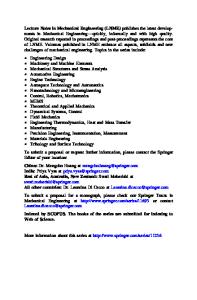Nanocrystalline- Matrix Ceramic Composites for Improved Fracture Toughness
- PDF / 214,459 Bytes
- 6 Pages / 612 x 792 pts (letter) Page_size
- 81 Downloads / 338 Views
Nanocrystalline-
Matrix Ceramic Composites for Improved Fracture Toughness
Joshua D. Kuntz, Guo-Dong Zhan, and Amiya K. Mukherjee Abstract This article focuses on nanocrystalline-matrix ceramic composites specifically designed for applications requiring improved fracture toughness. While the models and theory of toughening mechanisms for microcrystalline composites are well developed, the same cannot be said for their nanocrystalline counterparts. The difficulty in producing fully consolidated ceramic composites that retain a nanocrystalline structure is the main hurdle to thorough investigations in this area. Thus, much of the research on so-called nanocomposites has been on materials with microcrystalline matrices and nanometric second phases. In this article, we present the general principles of toughness mechanisms in microcrystalline ceramic composites, and then extend these ideas to consider how they should apply to ceramics with nanocrystalline matrices. While work in this area is still quite limited, we review current research focused on the production and testing of composites with nanocrystalline matrices and second phases, and we recap the results of some promising fracture toughness reports. Keywords: ceramics, fracture, nanocomposites, nanostructure, structural materials.
Introduction Nanocrystalline materials are known to possess unique physical and mechanical properties, including enhanced ductility and superplasticity,1 even in traditionally brittle materials; superior strength; and optical transparency in usually opaque ceramics.2,3 Pilot-scale facilities for nanopowder synthesis and the commercialization of sizable quantities of certain types of nano-sized powders have been achieved. The fabrication of nanopowders into fully dense components that retain a nanocrystalline grain size has lagged behind powder synthesis and characterization. In part, the gap between powder synthesis and fabrication is related to an incomplete theoretical understanding of the mechanisms and
22
consequences of densification and sintering when grain interfacial regions dominate. Equally relevant is the incomplete understanding of the particular experimental conditions that yield high-density compacts without microstructural coarsening. The available experimental work in this area clearly demonstrates that the conditions for densification and sinterability of nanocrystalline materials is systemspecific and is not readily deduced from theory alone at the present time. Due to the difficulty in producing ceramics with nanocrystalline-matrix grain sizes, most of the research on nanoscale effects in ceramic composites has been on composites with microcrystalline matrices and nanocrys-
talline second phases. These micro-nano composites have been extensively reviewed elsewhere,4,5 so this article focuses on the situation where the matrix is nanocrystalline.
Nanoceramics Advanced ceramic materials are attractive because of their low density, chemical inertness, high strength, high hardness, and high-temperature stability.
Data Loading...











